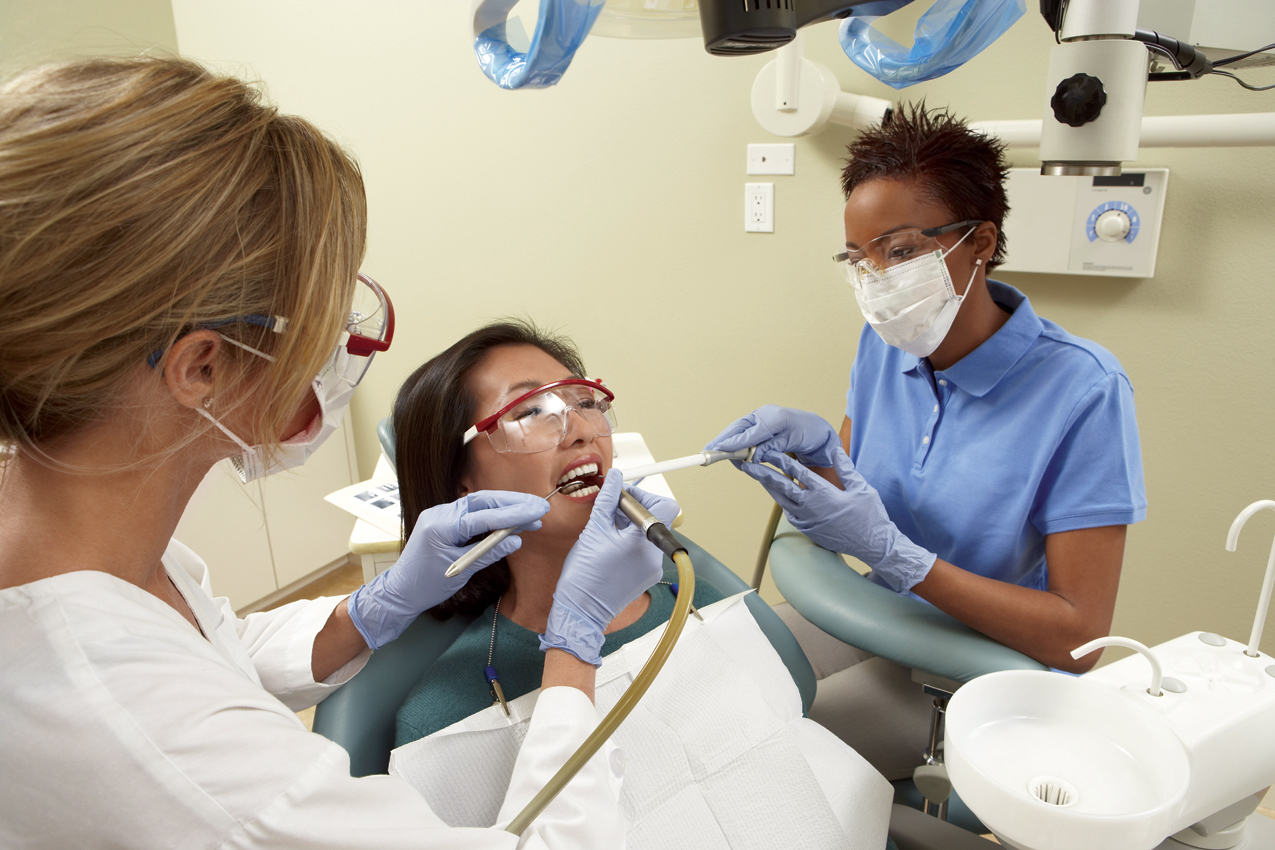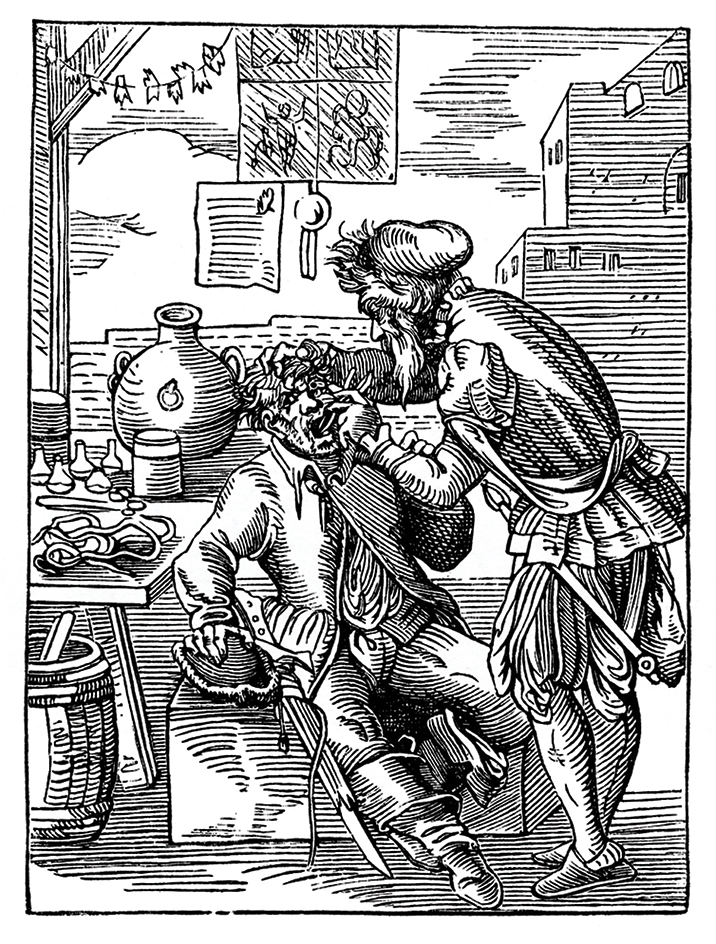Dentistry is the art and science of preventing, diagnosing, and treating diseases of the teeth, jaws, and surrounding soft tissues of the mouth. Dentists care for their patients in many ways, but mainly through their skill at recognizing, correcting, and preventing problems of the teeth and the tissues that support them.
Dental treatment includes a wide range of dental services. Some of these services focus on correcting problems of the teeth caused chiefly by dental decay (cavities). Such treatment, called restorative dentistry,_often involves the use of some kind of dental filling. Other dental services deal with the prevention and treatment of diseases of the teeth and their supporting tissues and nerves. Still others concentrate on the position of the teeth in relation to each other and to the jawbones. Sometimes teeth require removal. This process, usually performed using an _anesthetic (painkilling drug), is called extraction. Dentists may also treat injuries, infections, tumors, and various other conditions of the teeth, jawbones, and related tissues. Today, dentists may place restorations simply to improve the patient’s appearance, a practice known as esthetic or cosmetic dentistry.
Tooth decay
Dentistry is practiced in dental offices where one or a number of dentists treat patients. Dentistry is also practiced in large clinics, in hospitals, and in dental schools. In addition to training future dentists, dental schools also conduct research in new methods and materials to improve dental treatment.
Most dentists practice general dentistry, which involves all phases of dental practice. Dentists and hygienists teach patients proper techniques for cleaning teeth at home. They also help patients establish nutritious eating habits that help keep teeth and gums healthy. Dentists and specially trained dental hygienists also may clean the patient’s teeth in the office (see Dental hygiene). General dental treatment includes filling cavities, extracting teeth, and replacing lost teeth with bridges or dentures (see Teeth (Dental decay)). Difficult problems are often cared for by dental specialists.

Specialties of dentistry
A number of specialty branches of dentistry have been established. They include (1) orthodontics, (2) oral surgery, (3) periodontics, (4) prosthodontics, (5) oral pathology, (6) pediatric dentistry, (7) public health, (8) endodontics, and (9) radiology.
Orthodontics
specializes in the correction and prevention of irregularities of the position of teeth. These irregularities usually happen as the teeth grow during early childhood and may produce malocclusion (bad bite). The majority of malocclusions occur because the teeth are too large for the amount of jaw space available. As a result, the teeth become crowded. Orthodontists correct malocclusions with braces or other mechanical devices that move the teeth into a better position. They may also use orthodontic techniques to correct facial profile irregularities. See Orthodontics.
Oral surgery
is concerned with the surgical correction of oral problems. Many of these problems are associated with the third molars, also called wisdom teeth. These last teeth often have insufficient space or may be impacted (covered with tissue or bone). Oral surgeons also remove tumors and cysts from the mouth and treat teeth and jaw fractures caused by injuries. They also correct cosmetic problems of the jaws and face, using methods similar to plastic surgery.
Periodontics
deals with diseases of the tooth-supporting tissues—the bones surrounding the teeth, and the gum tissue (gingiva). Periodontal diseases are responsible for more tooth loss in adults than any other dental problem. They can be prevented by proper home and dental office care.
Prosthodontics
deals with the replacement of missing or damaged teeth. Replacement often involves the construction of complete or partial dentures, which are removable devices. Sometimes missing teeth are replaced by bridgework cemented to the remaining teeth. Implants placed in the bone may also support replacement teeth, which are made of plastic, porcelain, gold or other metals.
Oral pathology
deals mainly with the diagnosis of mouth diseases using laboratory procedures. Soft or hard tissues from the patient’s mouth may be examined with the aid of a microscope to identify tumors or other disorders. Some oral pathologists also specialize in forensic dentistry, which applies oral pathology to legal cases. These specialists are frequently called upon to identify dead people by comparing dental records with the teeth and tissues of the deceased.
Pediatric dentistry
specializes in the dental problems of children. Dentists who practice pediatric dentistry are called pedodontists. Children sometimes require special attention in treating dental decay and other problems. Pedodontists also care for other special patients, such as adults who have mental or physical disabilities.
Endodontics
involves prevention, diagnosis, and treatment of diseased pulp. The pulp is the central portion of the tooth that contains nerves and blood vessels. Severe dental decay and other injuries may cause infection or death of the pulp. This pulp can be removed by a process known as root canal treatment. Once removed, the pulp can be replaced with special filling material. Such treatment saves many teeth that would otherwise be lost.
Radiology
involves X rays and other images of the mouth and face and the interpretation of these images used in dentistry.
History
Early dentistry.
Human beings have always experienced dental problems. Stone Age people in what is today Pakistan were using dental drills made of flint 9,000 years ago to remove decay. The ancient Greeks, Romans, and Egyptians used various remedies for toothaches, including tooth extraction. In the Middle Ages, from the A.D. 400’s through the 1400’s, dentistry was practiced by such craftworkers as jewelers and barbers.

In 1728, Pierre Fauchard, a French dental scientist, published The Surgeon Dentist. This book detailed complex dental devices, instruments, and methods and is considered a landmark in the history of dentistry. Dentistry emerged as a profession in the mid-1800’s. In 1840, the world’s first dental school, the Baltimore College of Dental Surgery, was founded in Baltimore by the American dentists Horace Hayden and Chapin Harris. Lucy Hobbs became the first woman to graduate from dental school in the United States in 1866. At that time, poor diet and inadequate dental cleaning and maintenance caused many to lose at least half of their teeth before the age of 20.
Modern dentistry
began during the mid-1800’s with the introduction of anesthetics to relieve discomfort during dental procedures. Nitrous oxide was first used as a general anesthetic by the American dentist Horace Wells in 1844. Two years later, another American dentist, W. T. G. Morton, gave the first formal demonstration of the use of ether as an anesthetic (see Morton, William T. G.).
In 1884, the American physician William Halsted used cocaine to block pain sensations in the lower jaw. Cocaine was the first local anesthetic—that is, a drug that blocks pain in only part of the body and does not cause unconsciousness.
By 1900, the use of dental drills had become widespread in the United States. In addition, principles for filling cavities had been established through the work of the American dentist G. V. Black. These important developments, along with the discovery of X rays in 1895 and the use of silver filling materials, helped revolutionize dentistry. For the first time, good dental care and treatment was available to most people.
Since the 1950’s, the addition of fluorides to water supplies and toothpastes has greatly reduced tooth decay (see Fluoridation). The development of better drills and instruments has decreased the discomfort and time needed for dental treatment. In addition, the development of tooth-colored filling materials has enabled dentists to cover up unsightly discolorations, cracks, or gaps in teeth.
Careers
Dentistry in the United States and Canada is a large and well-organized profession. There are hundreds of thousands of dentists in the United States and Canada. The great majority of these are general dentists in private dental practices. Most of the remaining dentists work in the military, in public health, in various government organizations and dental societies, as consultants, or as teachers or researchers in dental schools. Individuals who want to become dentists must first attend a school of dentistry.
Educational requirements.
All dental schools require a high level of scholastic achievement before admission. Applicants must have at least three years of college education. However, most dental students are college graduates. In addition, prospective dental students must take a dental aptitude test. This test identifies those students who are most likely to succeed in dental subjects.
The usual course of study in dental school lasts four years. The first two years are devoted to studying basic medical and dental sciences, as well as dental laboratory techniques. Clinical aspects of dentistry are emphasized in the final two years of dental school, when students perform dental procedures on patients. Upon graduation, students receive either a Doctor of Dental Surgery (D.D.S.) degree or a Doctor of Dental Medicine (D.M.D.) degree.
Licensing.
All U.S. states and Canadian provinces require that dentists be licensed to practice. To obtain a license, a person must have a D.D.S. or D.M.D. degree from an approved school and must also pass a special examination. State and local dental societies work with state governments in administering licensing examinations.
Organizations.
The main professional organization of dentists in the United States is the American Dental Association. Some functions of this organization are to promote dentistry in matters of legislation, to inspect and approve dental schools, and to produce educational material for the public. Its headquarters are in Chicago, Illinois. The Canadian Dental Association (Association dentaire canadienne) serves a similar purpose in Canada. It has headquarters in Ottawa, Ontario.
See also American Dental Association; Hypnosis (Uses of hypnosis); Orthodontics; Prosthetics; Teeth.
